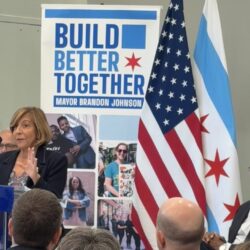SPRINGFIELD — After years of advocacy by lakefront Chicagoans urging city and state officials to do more to prevent dangerous driving on one of Chicago’s busiest traffic corridors, State Senator Sara Feigenholtz led a new law that will guide the state’s path toward reducing crashes and fatalities on DuSable Lake Shore Drive.
“DuSable Lake Shore Drive is one of our region’s most popular routes for families, visitors and commuters — but it’s also one of our most dangerous,” said Feigenholtz (D-Chicago). “Paving the way for real safety solutions will save lives and make it easier for Chicagoans and travelers alike to enjoy the miles of lakefront beauty.”
Every day, hundreds of thousands of passengers travel along the limited access expressway, which has a speed limit of 40-45 mph. Despite the limit, DLSD has functionally become a highway, with drivers regularly exceeding speeds of 70 mph or more. An average of about seven vehicle crashes per day since 2019 has added up to over 16,000 crashes and 4,000 injuries in the last five years. Combined with the fact that the Drive has no emergency shoulders and lacks guardrails in some areas, DLSD has become deadly. Despite consistent advocacy from lakefront residents to address these alarming trends, the most recent comprehensive renovations to DuSable Lake Shore Drive were made over 20 years ago.
Feigenholtz took action this spring after receiving multiple photos and videos from constituents who live along the Drive and regularly witness fatal and near-fatal accidents. Her new law directs the University of Illinois Chicago’s Urban Transportation Center to study crash data, risky driving behavior and whether traffic enforcement technologies could prevent hazardous driving on DLSD. Data on the use of traffic technology like randomized speed cameras in Germany and the Netherlands shows that the strategy is consistent, effective and has a long-term impact on incentivizing safer driving and behavior changes.
“I’ve heard from my constituents for years about speeding, crashes and accidents on neighborhood streets and on DLSD. What they asked for was simple: take action to save lives,” Feigenholtz said. “After years of patching band-aid solutions on this growing problem, we’re taking action to put safety first on our city’s iconic expressway.”
Senate Bill 1507 was signed into law Friday and goes into effect Jan. 1, 2026.
###



